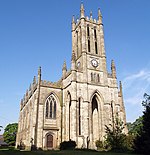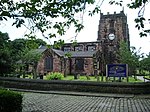Salford Hundred
History of Greater ManchesterHistory of SalfordHundreds of Lancashire

The Salford Hundred (also known as Salfordshire) was one of the subdivisions of the historic county of Lancashire, in Northern England (see:Hundred (county division). Its name alludes to its judicial centre being the township of Salford (the suffix -shire meaning the territory was appropriated to the prefixed settlement). It was also known as the Royal Manor of Salford and the Salford wapentake.
Excerpt from the Wikipedia article Salford Hundred (License: CC BY-SA 3.0, Authors, Images).Salford Hundred
Well Grove,
Geographical coordinates (GPS) Address Nearby Places Show on map
Geographical coordinates (GPS)
| Latitude | Longitude |
|---|---|
| N 53.5606 ° | E -2.2991 ° |
Address
Well Grove
Well Grove
M45 7SQ , Blackford Bridge
England, United Kingdom
Open on Google Maps







